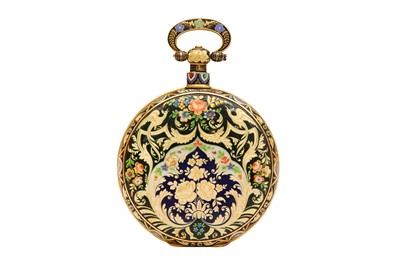24th Nov, 2022 14:00
Watches and Pens
JUST & SON POCKET WATCH FOR THE CHINESE EXPORT MARKET, QING DYNASTY
18K YELLOW GOLD AND ENAMEL, WATCH NO. 2155.
A RARE AND EXQUISITE JUST & SON POCKET WATCH, NO. 2155, 18K YELLOW GOLD, BASSE-TAILLE POLYCHROME ENAMELLED, OPEN-FACE WITH CENTRE SECONDS, MADE FOR FOR THE CHINESE EXPORT MARKET DURING THE QING DYNASTY.
Date: Circa 1831
Movement: Signed Just & Son, London, No. 2155, finely chased and engraved with flowers and foliate patterns, English lever escapement, duplex escapement with floral engravings, standing barrel, three-arm steel compensated balance with a diamond stone, engraved cuvette with floral design and stars.
Dial: White enamel, black Roman numerals, black outer minute division with black Arabic numerals for fifteen minutes divisions, gilt hands, blued central second hand
Case: Signed, 18k yellow gold and polychrome basse-taille enamel, the decoration being floral and with avian motifs, silver gilt inner dust cover with key aperture and floral motifs engraved, signed JS, No. 476...
Size: 55mm
Accompaniments: Key
Leonard Just headed his London workshop from 1790 until 1825 and was one of the most famous watchmakers of his time, specialising in watches produced for the Chinese export market. After his death, the business was taken over by his son, who rebranded the company as ‘Just & Son’.
Enamel on metal, as featured on this watch, has a long and complex history, rooted in more than three thousand years of production and featuring a vast range of techniques, applied to a wide variety of objects. Among the earliest practised enamelling methods, champlevé and cloisonné were undoubtedly the most popular. By the 17th and 18th centuries, innovative techniques like ‘basse-taille’ and painted enamel were introduced.
Enamel specialist Haydn Williams explained how fashion played a role in dictating which technique was the most fashionable, as styles and tastes came and went, in his seminal work “Enamels of the World 1700 – 2000: The Khalili Collections, 2009”. Alongside the changing dicates of fashion and tastes, the availability and selection of base metals and enamel colours for and by the craftsmen in an enameller’s workshop were crucial – perhaps even more important than fashion trends. This interconnection between, on the one hand the available materials and, on the other, the variety of technique desired in any situation would lead to the decisions – and designs – created by the craftsmen.
Turning to our watch, the neutral tone of its 18ct gold case blends elegantly with the enamelling on the exterior; this has been carried out in a technique called ‘basse-taille’, a technique first used in the late Middle Ages and then rediscovered and refined in the 17th century. In basse taille the craftsman creates a low-relief pattern in metal, usually silver or gold, by engraving or chasing. The entire pattern is created in such a way that its highest point is lower than the surrounding metal. A translucent enamel is then applied to the metal, allowing light to reflect from the relief and creating an artistic effect
During the Renaissance, the refinement and increasing use of transparent enamel obliged craftsmen to carefully consider the base metal surface that remained visible, as a ‘blank canvas’ which, once engraved with patterns and motifs, would give their work a new decorative dimension, whilst, practically, ensuring a greater adhesion of the enamel to the metal body. This technique became particularly popular for irregular, curved and uneven surfaces on items such as snuff boxes and pocket watches, allowing the light to play and give unusual effects from the different tones of the base metal working with the enamel pigments.
The designs on the case of our watch, with its abundant floral decoration, and its pair of phoenixes indicate that this pocket watch was indeed produced for the export market to the Far East; this fits in with other output from the Just & Son workshop. In China, the symbolism of the phoenix (fenghuang) has many auspicious associations, including prosperity, charity and beauty. As an emblem worthy of the Chinese empress, this motif was applied both to items created in Asia, as well as Western creations produced for export to the East. Similar examples of Chinese export market pocket watches by Western watchmakers like Bovet, Dimier Freres, and others can be found in the Macau Time Museum and in the British Museum (inv. no. 1958,1201.271). For a similar example, successfully sold at auction, please see Sotheby's Geneva sale of 13 May 2015, lot 52.
Dimensions: 55mm.
Sold for £11,875
Includes Buyer's Premium
Do you have an item similar to the item above? If so please click the link below to request a free online valuation through our website.












